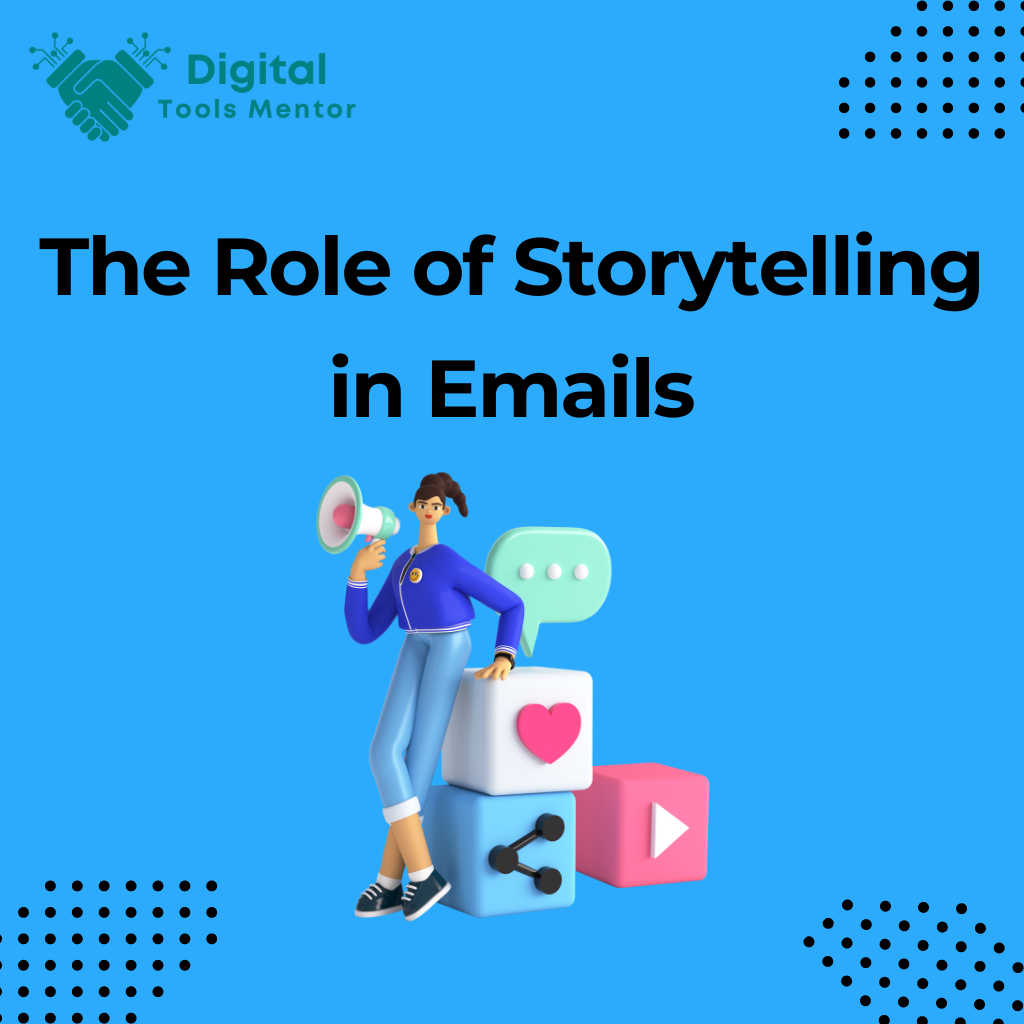The Art of Narratives: The Role of Storytelling in Email Marketing
In the world of marketing, storytelling is not just a tool; it’s a powerful conduit that connects businesses to their audiences on a deeply personal level. The art of storytelling transcends mere product promotion—it evokes emotions, builds relationships, and enhances the memorability of the message. When people hear a compelling story, they are more likely to feel a connection, remember the message, and ultimately, make a purchase based on emotional investment rather than just need. The role of storytelling in email marketing transforms standard promotional emails into engaging narratives that capture the reader’s interest from the subject line right through to the call-to-action. This approach leverages the intimate and direct nature of email as a communication channel, making it an ideal medium for telling stories that are personal, relatable, and persuasive. Whether it’s sharing the journey of a product, the story behind a brand, customer testimonials, or creative fictional narratives that align with marketing goals, storytelling within emails can significantly enhance the effectiveness of digital marketing campaigns.
In this blog post, we will explore how to harness the power of storytelling in email marketing to not only increase engagement and open rates but to forge stronger connections with subscribers, encouraging loyalty and driving conversions.

The Psychology Behind Storytelling in Marketing
Storytelling is a fundamental human experience and a powerful psychological tool in marketing that taps into our brains’ natural wiring for narrative processing. Understanding the psychological underpinnings of why stories resonate can help marketers craft more effective and emotionally engaging content, especially in the realm of email marketing.
How Stories Engage the Human Brain
- Neural Coupling:
- Stories activate a process known as neural coupling. This phenomenon allows the listener’s brain to turn the story into their own ideas and experience, thanks to the mirror neurons that fire in sync with the action being described. This makes the narrative more engaging and relatable.
- Emotion Elicitation:
- Emotional engagement is crucial for effective storytelling. Stories have the power to evoke strong emotions such as joy, sadness, anger, or empathy. Emotional content captures attention more effectively than factual listings of product features because it stimulates the amygdala, the part of the brain responsible for emotional processing.
- Decision-Making Influence:
- Emotions from a well-told story can influence a person’s decision-making processes. The limbic system, which processes emotions, also plays a significant role in decision-making. Affective content can make consumers feel more connected to a brand, swaying their purchase decisions favorably.
Connection Between Storytelling and Memory Retention
- Memorable Content:
- Stories are memorable. They structure information in a way that our brains find easy to remember. The narrative format provides a logical flow and context, which enhances retention. This is crucial in marketing, where brands strive to remain top-of-mind for consumers.
- Sensory Activation:
- Effective stories often engage multiple senses. When stories make listeners visualize scenes, hear sounds, or imagine touching objects, they activate various sensory areas of the brain. This multisensory engagement can make the experience more vivid and the information more retrievable.
- Dopamine Release:
- Engaging stories can trigger the release of dopamine into the system, associated with positive feelings and reward. Dopamine not only makes the experience enjoyable but also improves focus and memory retention. When an email story makes a reader feel good, the dopamine release increases the chances they will remember the message and brand.
- Context and Relevance:
- Stories often include familiar scenarios or relatable challenges which provide context and relevance to the listener. When people find content relevant, they pay closer attention, and the information is more likely to be encoded into long-term memory.
In email marketing, leveraging these psychological insights can transform ordinary messages into compelling narratives that engage readers, influence their emotional responses, and create memorable interactions with the brand. This not only helps in building lasting customer relationships but also drives conversion by aligning the brand’s values and message with the customers’ needs and emotions.
Benefits of Storytelling in Emails
Storytelling in email marketing isn’t just about sharing tales—it’s a strategic approach that can lead to measurable benefits in engagement, relationship building, and conversions. Here’s how integrating storytelling into your email campaigns can transform the effectiveness of your marketing efforts.
Enhance Engagement and Open Rates
- Captivating Subject Lines:
- A story-driven subject line can spark curiosity and stand out in a crowded inbox. By promising a narrative, these subject lines encourage recipients to click through to discover the story, significantly improving open rates.
- Sustained Interest:
- Once opened, a compelling story keeps the reader engaged. Unlike standard promotional emails, which might be quickly scanned, a narrative can hold attention from beginning to end, increasing the time spent on your email and enhancing the engagement with your content.
Build Stronger Relationships with Subscribers
- Emotional Connection:
- Stories can humanize your brand by conveying values and personalities that resonate with subscribers. By sharing stories about challenges, successes, or behind-the-scenes insights, you create emotional touchpoints. This emotional resonance can foster a sense of connection and loyalty to your brand.
- Consistent Storytelling:
- Regular storytelling can reinforce a consistent brand image and voice. Over time, subscribers come to anticipate and appreciate the stories you share, which builds a deeper relationship based on familiarity and sustained interaction.
Increase Conversion Rates
- Relatable Content:
- By presenting information within the context of a relatable story, you make your brand more approachable and your messages more digestible. For example, a customer success story can illustrate the benefits of a product in a real-world scenario, making it easier for subscribers to see the value and how it could apply to their own lives.
- Persuasive Storytelling:
- A well-crafted story can subtly guide readers to a desired action without the overt pressure of traditional sales tactics. The narrative can lead them naturally to the conclusion that buying a product, signing up for a service, or engaging with a brand is the beneficial next step in their own story.
Incorporating storytelling into your email marketing strategy offers a dynamic way to capture and maintain your audience’s attention, deepen relationships with more personalized interactions, and drive stronger conversions through relatable and emotionally compelling content. This approach not only elevates the effectiveness of your campaigns but also enhances the overall perception of your brand.
Explore 23 Best Email Marketing Platforms in 2025
Elements of a Good Story
A captivating story, whether in a novel, movie, or email, shares common foundational elements that draw in the audience and keep them engaged until the end. Understanding these elements—setting, characters, conflict, and resolution—is crucial for crafting compelling narratives in your email marketing campaigns.
Setting
- Definition: The setting of a story refers to the time and place where it occurs. In an email, the setting provides the backdrop that helps paint a vivid picture in the reader’s mind.
- Adaptation to Email: Establish the setting at the beginning of your email to set the context. For example, if you’re promoting a winter sale, you might set your story in a cozy, snowy scene to evoke the feelings of warmth and comfort that come with finding the perfect winter gear.
Characters
- Definition: Characters are the individuals involved in the story. In marketing, these are often representatives of your target audience, relatable figures, or even the brand itself personified.
- Adaptation to Email: Introduce characters that your subscribers can relate to, such as a customer who has faced a challenge that your product or service has resolved. This helps to create an emotional connection and makes the narrative more engaging.
Conflict
- Definition: Conflict is the challenge or problem that the characters in the story must overcome. It is the driving force of the narrative.
- Adaptation to Email: The conflict should resonate with your audience’s needs or pain points. Describe a common problem your subscribers might face, emphasizing how your brand or product offers the solution. This not only captivates but also positions your offering as the necessary resolution.
Resolution
- Definition: The resolution is how the conflict is resolved. It wraps up the story, providing closure to the audience.
- Adaptation to Email: Conclude your email by showing how your product or service solves the conflict introduced earlier. This could be through a customer testimonial, a product demonstration, or a simple explanation of your solution’s benefits. Ensure the resolution clearly ties back to the call to action, encouraging readers to take the next step, be it making a purchase, signing up for more information, or another desired action.
How to Adapt These Elements in Email Format
- Brevity and Clarity: Unlike long-form stories, emails need to be concise. Each element should be clearly and quickly articulated to keep the reader’s attention.
- Visuals and Formatting: Use images, headings, and bullet points to help illustrate the setting and characters, highlight the conflict, and depict the resolution.
- Engaging Flow: Structure your email to seamlessly transition from one element to another, guiding the reader through the setting and conflict to the resolution in a way that naturally leads to your call to action.
By incorporating these classic storytelling elements into your emails, you can create more meaningful and memorable marketing messages that resonate deeply with your audience, leading to higher engagement and increased conversions.
Crafting Your Story
Creating a compelling story in an email requires a thoughtful approach that intertwines narrative elements with your marketing objectives. Here’s a step-by-step guide to crafting an effective story for your email campaigns, along with insights on the importance of tailoring the narrative to your audience.
Step-by-Step Guide to Crafting an Effective Email Story
- Understand Your Audience:
- Begin by researching and understanding your audience’s demographics, preferences, and pain points. This knowledge is crucial for tailoring your story to resonate with the readers.
- Define the Purpose:
- Clearly define what you want to achieve with your email. Are you trying to inform, persuade, or entertain? Your goal will guide the tone and structure of your story.
- Choose a Relatable Theme:
- Select a theme that aligns with your audience’s interests or addresses their needs. This could be overcoming a challenge, achieving a goal, or making a discovery.
- Develop Characters and Setting:
- Create characters that your audience can identify with. These could be based on typical customer profiles. Establish a setting that adds context and enriches the story.
- Introduce the Conflict:
- Clearly outline a conflict or problem that your character faces, which should mirror the challenges your audience might encounter.
- Offer a Resolution with Your Product/Service:
- Show how the conflict can be resolved using your product or service. This part of the story should naturally introduce how your offering is the best solution.
- Craft a Strong Opening and Conclusion:
- Start with a hook that grabs attention right away—perhaps a question, a surprising fact, or a bold statement. Conclude with a clear and compelling call-to-action that ties back to the resolution.
- Use Engaging Visuals:
- Incorporate visuals that support or enhance the story. This could include images of the characters, infographics, or even animations that help illustrate the conflict and resolution.
- Edit for Clarity and Brevity:
- Review your story to ensure it is clear and concise. Email stories need to be significantly shorter than traditional stories, so every word must be impactful.
- Test and Iterate:
- Test different versions of your story with segments of your audience to see which resonates best. Use feedback and engagement metrics to refine and improve your narrative.
Importance of Knowing the Audience
Understanding your audience is fundamental in storytelling, especially in email marketing. Knowing the audience helps in several ways:
- Tailoring Content: You can create content that speaks directly to the interests, needs, and challenges of your readers, making the story more engaging and relevant.
- Emotional Connection: By addressing specific desires or pain points, you establish an emotional connection, increasing the likelihood of engagement and action.
- Personalization: Detailed audience knowledge allows for deeper personalization, which can enhance the effectiveness of your emails by making them feel uniquely tailored to each recipient.
Crafting your story with a deep understanding of your audience ensures that your email not only captures attention but also holds it, ultimately guiding subscribers towards the desired action. This approach not only elevates the user experience but also boosts the overall success of your email marketing campaigns.
Integrating Storytelling with Email Marketing Goals
Storytelling in email marketing can be a powerful tool to achieve various strategic objectives, including enhancing brand awareness, generating leads, and retaining customers. By effectively aligning your storytelling efforts with these goals, you can create emails that not only engage but also drive meaningful actions that contribute to your business’s success.
Aligning Storytelling with Marketing Goals
- Brand Awareness:
- Objective: Increase recognition and understanding of your brand.
- Storytelling Approach: Craft stories that highlight your brand’s values, history, or unique selling propositions. These stories should communicate what sets your brand apart in a memorable way.
- Example: A company could send an email series detailing its journey from a small startup to a key industry player, emphasizing its commitment to quality and innovation, helping subscribers connect with the brand’s heritage and ethos.
- Lead Generation:
- Objective: Capture the interest of prospects and convert them into leads.
- Storytelling Approach: Use stories to illustrate the problems your products solve in an engaging way. These should prompt readers to seek more information or make a direct inquiry.
- Example: A technology firm could share a customer success story where their product solved a significant industry problem, concluding the email with a call-to-action (CTA) to sign up for a free trial or consultation.
- Customer Retention:
- Objective: Keep existing customers engaged and loyal.
- Storytelling Approach: Tell stories that make customers feel valued and part of a community. Share customer testimonials, user-generated content, or stories about how customer feedback has shaped the product.
- Example: A subscription-based service could send out monthly emails featuring stories from real users describing how the service has positively impacted their lives, reinforcing the value of staying subscribed.
Tips for Storytelling in Different Marketing Objectives
- Personalize the Narrative: Tailor stories to match the interests and behaviors of different segments of your audience. Personalization can increase the relevance and impact of your stories, making them more effective at achieving your marketing goals.
- Visual Storytelling: Incorporate images, videos, or infographics that complement the narrative. Visual elements can help illustrate points more vividly and make the emails more engaging.
- Consistent Brand Voice: Ensure that all your stories reflect a consistent brand voice and style. This consistency helps reinforce brand identity and can enhance trust and recognition among your audience.
- Measure and Adapt: Continuously measure how well your storytelling aligns with your marketing goals and adapt based on performance. Use metrics like open rates, click-through rates, and conversion rates to gauge effectiveness and refine your approach.
By strategically integrating storytelling with your broader marketing objectives, you can create more compelling email campaigns that not only engage your audience but also drive them towards your desired business outcomes.
Storytelling Techniques to Try
In email marketing, the art of storytelling can be elevated through various techniques that enhance the narrative and make the content more engaging. Techniques like metaphors, anecdotes, user-generated content, and case studies each have their unique strengths and can be implemented to achieve different effects. Here’s how you can effectively use these techniques in your email campaigns.
Metaphors
- Usage: Metaphors can make complex or abstract concepts easier to understand by relating them to familiar experiences. They can also add a layer of richness and depth to your narratives.
- Implementation in Email Marketing: Use metaphors to connect your product or service with everyday experiences that resonate with your audience. For example, if you’re marketing a cybersecurity service, you might compare it to a “digital fortress” that protects valuable assets.
Anecdotes
- Usage: Anecdotes are short, personal stories that illustrate a point or teach a lesson. They are highly relatable and can effectively humanize your brand.
- Implementation in Email Marketing: Include real stories about how your products or services have impacted individuals or businesses. Start your email with an anecdote to hook readers right away, then transition into how your offering can similarly benefit them.
User-Generated Content
- Usage: User-generated content (UGC) refers to any form of content created by users or customers, such as reviews, testimonials, photos, or videos. UGC adds authenticity and trustworthiness to your narrative.
- Implementation in Email Marketing: Share stories and content created by your users to demonstrate the real-world value of your offerings. For instance, feature a customer’s story or testimonial in your email that highlights their positive experience with your brand. This not only shows your product in action but also builds social proof.
Case Studies
- Usage: Case studies are comprehensive accounts of a customer’s experience with your product or service. They are detailed and data-driven, making them particularly persuasive.
- Implementation in Email Marketing: Develop case studies that tell a story of transformation or success. Use them in your emails to outline specific scenarios where your product or service solved significant problems or delivered substantial benefits. Be sure to highlight specific outcomes and statistics to add credibility.
How to Effectively Implement These Techniques
- Integrate Visually: Alongside textual storytelling, integrate relevant visuals that complement and enhance the story. Visuals can help illustrate the points made through metaphors, showcase the people involved in anecdotes, or highlight the key outcomes in case studies.
- Segment and Personalize: Tailor your stories to the interests and needs of different segments of your audience. Personalization makes your stories more relevant and engaging to each recipient.
- Clear and Concise: While storytelling can add depth to your emails, it’s important to keep the narrative clear and concise. Avoid overly complex language or convoluted plots that could distract or confuse the reader.
- Strong Call-to-Action: Ensure each story has a clear purpose by linking it to a strong call-to-action (CTA). Whether it’s encouraging readers to learn more, buy a product, or get in touch, the CTA should seamlessly connect with the story’s message.
By employing these storytelling techniques, you can create more engaging and impactful email content that captures attention, conveys value, and compels action.
Case Studies of Successful Storytelling in Emails
Effective storytelling can transform standard email marketing into a powerful engagement tool. Here are a few real-world examples from brands that have mastered storytelling in their email campaigns, showcasing different approaches and techniques that made their stories stand out.
1. Airbnb
Storytelling Approach: Airbnb often uses stories from real hosts and travelers to showcase the unique experiences available through their service. They focus on the personal touches that hosts add to the stay, or the unexpected adventures that travelers encounter.
Effectiveness: These stories are effective because they make the concept of traveling and hosting seem accessible and rewarding. They also help to humanize the brand and create a sense of community among users.
Presentation: Airbnb emails typically feature beautiful imagery of the locations and smiling faces of hosts and guests, accompanied by a short narrative describing the featured story. The emails are visually appealing and engage readers with a glimpse into real-life experiences that could be theirs.
2. Patagonia
Storytelling Approach: Patagonia’s emails often focus on environmental advocacy, highlighting stories about conservation efforts and the impact of sustainable practices. They connect their products to these stories, emphasizing the brand’s commitment to environmental causes.
Effectiveness: The use of storytelling underscores Patagonia’s brand values and reinforces customer loyalty among those who share these values. It goes beyond product promotion, engaging readers on an ideological level.
Presentation: The emails are presented with compelling photographs and videos of nature and conservation efforts, paired with narratives that detail the efforts and how customers can participate or contribute, often linking back to products that are ethically made or directly contribute to these efforts.
3. Warby Parker
Storytelling Approach: Warby Parker utilizes customer stories to highlight their “Buy a Pair, Give a Pair” program. They share specific examples of people whose lives have been impacted by customers’ purchases, which include donations of eyewear to those in need.
Effectiveness: These stories directly illustrate the impact of customers’ decisions to buy from Warby Parker, making the purchase more meaningful. It shows customers that their choices have a real-world positive impact.
Presentation: The emails are clean and straightforward, with images of the beneficiaries and a short story about the difference the glasses have made in their lives. This direct connection between purchase and impact makes the narrative compelling and persuasive.
4. Charity: Water
Storytelling Approach: Charity: Water’s email campaigns often tell the stories of individual communities or families that have gained access to clean water through their initiatives. They detail the challenges faced before and the changes after the intervention.
Effectiveness: These stories are powerful because they are deeply personal and highlight a significant change. They make the concept of donating more tangible by showing exactly where and how the money is used.
Presentation: Their emails include photos or videos that document the stories, complemented by text that explains the situation and the outcomes. The emotional impact of seeing the difference made helps to drive donations.
These examples illustrate how integrating storytelling into email campaigns can significantly enhance engagement and loyalty by making the brand’s message resonate on a deeper emotional level. By focusing on real stories that align with their brand values and goals, these companies effectively connect with their audiences, demonstrating the profound impact of storytelling in marketing.
Common Pitfalls to Avoid in Email Storytelling
Incorporating storytelling into email marketing can significantly enhance engagement and effectiveness. However, there are common pitfalls that can detract from the success of your storytelling efforts. Recognizing and avoiding these mistakes can help ensure that your stories resonate with your audience and achieve your marketing objectives.
1. Overcomplicating the Story
Pitfall: Creating stories that are too complex or contain too many characters can confuse readers and dilute the main message.
Tip: Keep your stories simple and focused. Concentrate on a single main character or a straightforward narrative that clearly ties back to your call to action. This clarity will help maintain the reader’s interest and make the message easy to understand.
2. Losing Brand Relevance
Pitfall: While a story might be engaging, it can sometimes stray too far from your brand’s message or the purpose of the email, leading to a disconnect.
Tip: Ensure that every story you tell is tightly aligned with your brand’s values and marketing goals. The story should naturally lead into your call to action and highlight the benefits of your product or service.
3. Neglecting the Audience’s Interests
Pitfall: Marketers sometimes tell stories that they find interesting or that showcase their product, but these stories may not resonate with or even interest the audience.
Tip: Always tailor your stories to the interests and needs of your target audience. Use data from customer interactions, feedback, and preferences to craft stories that address their specific concerns, desires, or pain points.
4. Underutilizing Visuals
Pitfall: Relying too heavily on text and not incorporating visual elements can make the email less engaging and visually monotonous.
Tip: Enhance your stories with relevant visuals like images, infographics, or videos. Visuals can help illustrate points, add emotional depth, and break up text, making the email more engaging and easier to digest.
5. Inconsistent Tone and Style
Pitfall: Inconsistent tone or style can confuse readers and weaken brand identity, especially if the story’s voice doesn’t match your usual brand communications.
Tip: Develop a consistent narrative style and tone that reflects your brand and stick to it across all your communications. This consistency helps build a strong, recognizable brand voice that your audience will come to know and trust.
6. Failing to Optimize for Mobile
Pitfall: Not considering how your email and its narrative components display on mobile devices can lead to poor user experiences.
Tip: Always ensure that your emails are mobile-friendly, with readable text sizes and responsive images. Many users read emails on their phones, so a mobile-optimized design is crucial to keeping your audience engaged.
By being mindful of these pitfalls and actively working to avoid them, you can ensure that your storytelling not only captivates and engages but also effectively communicates your brand’s message and drives your intended marketing results.
Conclusion
Storytelling in email marketing is a powerful technique that can transform ordinary campaigns into engaging narratives that resonate deeply with audiences. By integrating storytelling, marketers can enhance email engagement, strengthen relationships with subscribers, and increase conversion rates. Effective storytelling involves understanding your audience, using clear and simple narratives, integrating visuals, and ensuring every story aligns with your brand’s message and marketing goals.
Embracing storytelling in your email campaigns can bring a host of benefits: from making your messages more memorable and emotionally impactful to differentiating your brand in a crowded market. I encourage all marketers to experiment with different storytelling techniques, tailor them to their audiences, and observe the positive changes in engagement and conversions. Let your brand’s unique voice and stories lead your email marketing to new heights of success.
FAQs
- What makes a good story in email marketing?
- A good story is relatable, simple, aligns with brand values, and has a clear message.
- How does storytelling increase email engagement?
- It captures interest with compelling narratives, keeping readers engaged longer.
- Can storytelling in emails improve open rates?
- Yes, intriguing stories and subject lines can significantly boost open rates.
- What are some effective storytelling techniques for emails?
- Using metaphors, anecdotes, user-generated content, and case studies are effective.
- How do I align storytelling with my email marketing goals?
- Ensure stories resonate with brand objectives and lead naturally to calls to action.
- What are common pitfalls in email storytelling?
- Overcomplication, losing brand relevance, and neglecting mobile optimization are common issues.
- How important are visuals in email storytelling?
- Very; they enhance the narrative and make emails more engaging.
- Should every email include a story?
- Not necessarily, but integrating stories frequently can improve overall engagement.
- How can I measure the success of storytelling in my campaigns?
- Track metrics like open rates, click rates, and conversion rates to gauge impact.
- What should I do if my storytelling isn’t working?
- Reassess your audience’s interests, refine your narratives, and consider testing different approaches.




